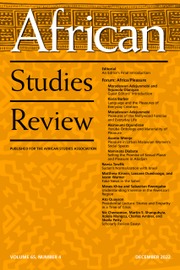Part of review forum on “Navigating Cultural Memory: Commemoration and Narrative in Post-Genocide Rwanda”
As a researcher of Rwanda’s postgenocide transition (Hudani Reference Hudani2024), I often think of Rwanda Studies as a polarized field. There are a number of scholars who consider the complexity of cohabitation and rebuilding (e.g. Ingelaere Reference Ingelaere2016; Longman Reference Longman2017; Purdeková Reference Purdeková2015). For some, the state is portrayed as obdurately authoritarian and an obstacle to lasting social conciliation (Meierhenrich Reference Meierhenrich2024; Thomson Reference Thomson2018). More popular narratives often advocate for the developmental strides the “new Rwanda” has made under the Rwandan Patriotic Front (RPF) government, in securing a period of internal stability. Between my necessarily simplified groupings are different positional experiences: each researcher’s entry to working in Rwanda has been colored by different personal experiences in the country that temporal durée and positionality made visible.
As a Rwandan present in the early days of the 1994 “genocide against the Tutsi” and a diasporic member familiar with canons of memory studies and debates on transitional justice, David Mwambari translates his positionality to frame an account of memory, narrative formation, and commemoration in Rwanda in the two decades after 1994. His book is singularly nuanced and illuminates the complex dynamics of memory and remembering after genocide. He harnesses a detailed accounting of mnemonic threads within Rwanda, and situates his scholarship in relation to studies of memory after mass violence from a decolonial perspective. Mwambari centers Rwanda in relation to the complexity of memory studies in the Global South, challenging readers to think through and beyond the Euro-American canon of memory studies that has both shaped Holocaust-like memorials in Rwanda, and unearthed the limits of such national commemoration in a shifting mnemonic landscape.
In the book’s Introduction, Mwambari narrates two meaningful encounters during his research. In the first, set in 2007, Mwambari meets Kayitesi, a survivor of the genocide living in rural Rwanda. She lost both parents during the genocide and is now indifferent to the annual commemoration events and the official state narrative. Her apparent apathy, what Mwambari later names as a “fatalist” orientation in relation to official commemoration ceremonies, contrasts with another meeting in 2009. Here, Hakizimana is also a rural dweller but in this case his father has been imprisoned for genocide charges. As the author’s age-mate, Mwambari is curious about Hakizimana’s contrasting views to that of his imprisoned father: the shame rather than bitterness Hazimana expresses, and his support for the programs of the postgenocide government contrast with expected antagonism felt by some accused of genocide crimes and their family members. These two cases illustrate the complexity of the mnemonic terrain Mwambari navigates as a Rwandan diasporic researcher, for whom the events of 1994 have been proximate and traumatic.
At its core, Mwambari’s greatest achievement in this sensitively rendered book is the nuance with which he treats accounts of the shifting positions of those who create and respond to the official narratives of the postgenocide state. Mwambari unearths the malleability of memory after mass atrocity and the ambivalence that exists as different actors negotiate living together and remembering together—co-creating memory and commemorating genocide and violence through and beneath the frame of the nation-state. Three core mnemonic orientations exist in relation to the increasingly entrenched state master-narrative that has become a hegemonic form of memory: those who are “Champions” of this narrative, those who are “Antagonists,” opposed to the official commemorative position and those who are “Fatalists” or who are dismissive of or ambivalent toward the genocide narrative as it shifts over time. Mwambari shows that memory is shapeshifting and not fixed in time—some “Champions” eventually become critics of differing shades, and children of “Antagonists” often adopt state accounts of events.
His adept demonstration of the malleability of memory after genocide is one of Mwambari’s greatest contributions both to Rwanda studies and to transnational memory studies more generally. For example, in Chapter Three, Mwambari details the shifts in official commemoration discourse during the first two decades following the end of the genocide in July 1994, demonstrating the increased solidification of a master-narrative formalizing Tutsi victimhood and the imperative toward national rebuilding around a particular trope of collective memory. Narratives of unity and nation-building that take the named “Genocide against the Tutsi” as their focal point are thereby analytically excavated in the book and meticulously traced through time. Mwambari’s scholarly analysis also treats the formation of memorials as opposed to vernacular memory (Chapter Four), and centers the role of the arts, media and public discourse (Chapters Six and Seven) through an examination of artists central to developing what he terms the state “master-narrative” as a hegemonic form of national memory.
For Mwambari, the solution to Rwanda’s mnemonic divides is not impasse, but a form of practice centered on the Kinyarwanda term “agaciro,” or dignity, which roots lived experiences and recognizes the malleability of positionality over time and across generations. Here, Mwambari could have elaborated further on the state appropriation of agaciro as a term in unity and reconciliation initiatives—as he has done in earlier work—as opposed to more organic uses of relational dignity in daily life (Mwambari Reference Mwambari2021). Overall, this remains a minor point in what is a much-needed contribution to the literature on memory in Rwanda studies and decolonial mnemonics, one that is exceptionally thorough, and in a word, outstanding.


